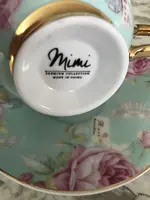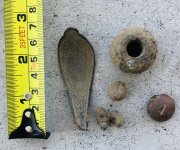You are using an out of date browser. It may not display this or other websites correctly.
You should upgrade or use an alternative browser.
You should upgrade or use an alternative browser.
Mimi tea cup: my husband came home with a box full of glassware at an estate sale. Curious if this is worth anything? It’s in perfect condition.
- Thread starter Rache
- Start date
It's a nice piece. 20th century. Try finding a similar one on Ebay or Etsy for value. Most folks aren't into collecting china these days - and I have three sets! It is a pretty pattern.
But wait, there's more, since I'm not going anywhere today. There is one on Ebay $29.99.

But wait, there's more, since I'm not going anywhere today. There is one on Ebay $29.99.

MIMI BLUE & WHITE PINK PEONY FLOWERS PINK BUTTERFLIS GOLD HANDLE TEACUP & SAUCER | eBay
TEA CUP 2 5/8" X 4".
www.ebay.com
Emil W
Sr. Member
- Nov 4, 2021
- 476
- 1,087
- Detector(s) used
-
Deus 2
Deus
Deus Lite
Garrett Apex
Garrett Pinpointer
BH Discovery 2200
BH Pioneer EX
White's Coinmaster 6000D (have had for decades)
- Primary Interest:
- Metal Detecting
When using eBay for an idea on what things sell for be aware that sellers can ask anything they want for an item--it doesn't mean someone will buy it at that price. Always search completed sales, not items currently for sale, to get an idea of what buyers are willing to pay.
The price being asked for the one in your eBay link is on the high side of what you'll find similar pieces for in a higher-end antique or collectables shop, which is considerably higher than what people will normally pay, and at that price I'd expect it to sit unsold for quite a long time unless someone who's looking for a replacement in the exact same pattern happens to find it, in which case they may indeed pay the asking price.
I've spent decades buying and selling at small, local auctions, as well as at the largest international auctions. Common modern tea sets such as the one in question can be found regularly at most local auctions where they regularly sell for a couple dollars up to as much as $10 on very good day.
The price being asked for the one in your eBay link is on the high side of what you'll find similar pieces for in a higher-end antique or collectables shop, which is considerably higher than what people will normally pay, and at that price I'd expect it to sit unsold for quite a long time unless someone who's looking for a replacement in the exact same pattern happens to find it, in which case they may indeed pay the asking price.
I've spent decades buying and selling at small, local auctions, as well as at the largest international auctions. Common modern tea sets such as the one in question can be found regularly at most local auctions where they regularly sell for a couple dollars up to as much as $10 on very good day.
- Feb 3, 2009
- 37,434
- 138,745
- 🥇 Banner finds
- 1
- Detector(s) used
- Deus, Deus 2, Minelab 3030, E-Trac,
- Primary Interest:
- Relic Hunting
A few years ago cup and saucer sets were getting really good prices, for the quality made ones.When using eBay for an idea on what things sell for be aware that sellers can ask anything they want for an item--it doesn't mean someone will buy it at that price. Always search completed sales, not items currently for sale, to get an idea of what buyers are willing to pay.
The price being asked for the one in your eBay link is on the high side of what you'll find similar pieces for in a higher-end antique or collectables shop, which is considerably higher than what people will normally pay, and at that price I'd expect it to sit unsold for quite a long time unless someone who's looking for a replacement in the exact same pattern happens to find it, in which case they may indeed pay the asking price.
I've spent decades buying and selling at small, local auctions, as well as at the largest international auctions. Common modern tea sets such as the one in question can be found regularly at most local auctions where they regularly sell for a couple dollars up to as much as $10 on very good day.
Now the trend isn't there any longer it seems.
I see them going for a what you quoted now.
Emil W
Sr. Member
- Nov 4, 2021
- 476
- 1,087
- Detector(s) used
-
Deus 2
Deus
Deus Lite
Garrett Apex
Garrett Pinpointer
BH Discovery 2200
BH Pioneer EX
White's Coinmaster 6000D (have had for decades)
- Primary Interest:
- Metal Detecting
The antiques market has changed dramatically within the past 15-20 years. I have quite a few collections, mostly started over 35 years ago when I began regularly attending auctions--at least two per month but often more. It's easy to become interested in different areas to collect when you see literally thousands of things auctioned off every month. And patterns in what sells and what doesn't emerge when you attend so often and for so long and those patterns evolve pretty consistently over time.
Basically, as the oldest generation of collectors die off (no disrespect intended), the types of things they collected often aren't appealing to the next generation and so those prices drop. This only applies to the common pieces. A rare item will generally hold a greater percent of the value it held at it's peak of popularity, common pieces usually drop close to zero unless sold as part of a group.
This is exactly what has happened to most porcelain. I've collected 17th-18th century Chinese, English, and European porcelain since the '80 when they had considerable value. The rarer pieces in my collection are still very much sought after and values have remained high, although they have dropped. I don't even bother buying the more common pieces anymore, even when I can find one for $50 that 20 years ago I gladly paid a few hundred for. Luckily for me I've always collected rarer pieces so most of my collection is still worth collecting.
My kids don't have any attachment to most of my collections and they'll likely sell them off when my wife and I are gone. I'm fine with that. I don't expect them to have the same interests as I do. But I do have every collection cataloged, including estimated values. But I've told them only to use the values as a guide to which are the better pieces and that they'll likely get much less than the estimates unless they plan on spending years selling items individually, after researching the best market for each. Realistically, I can't expect them to put that mush time into it and they understand I'm fine with whatever they choose to do.
Basically, as the oldest generation of collectors die off (no disrespect intended), the types of things they collected often aren't appealing to the next generation and so those prices drop. This only applies to the common pieces. A rare item will generally hold a greater percent of the value it held at it's peak of popularity, common pieces usually drop close to zero unless sold as part of a group.
This is exactly what has happened to most porcelain. I've collected 17th-18th century Chinese, English, and European porcelain since the '80 when they had considerable value. The rarer pieces in my collection are still very much sought after and values have remained high, although they have dropped. I don't even bother buying the more common pieces anymore, even when I can find one for $50 that 20 years ago I gladly paid a few hundred for. Luckily for me I've always collected rarer pieces so most of my collection is still worth collecting.
My kids don't have any attachment to most of my collections and they'll likely sell them off when my wife and I are gone. I'm fine with that. I don't expect them to have the same interests as I do. But I do have every collection cataloged, including estimated values. But I've told them only to use the values as a guide to which are the better pieces and that they'll likely get much less than the estimates unless they plan on spending years selling items individually, after researching the best market for each. Realistically, I can't expect them to put that mush time into it and they understand I'm fine with whatever they choose to do.
I also agree the trend with antiques is going downhill. The younger set wants vintage video games.
Top Member Reactions
-
 2583
2583 -
 1145
1145 -
 1050
1050 -
 907
907 -
 887
887 -
 845
845 -
 804
804 -
 699
699 -
 642
642 -
 540
540 -
 488
488 -
 473
473 -
 472
472 -
 466
466 -
 463
463 -
O
440
-
 421
421 -
 390
390 -
 380
380 -
 362
362
Users who are viewing this thread
Total: 2 (members: 0, guests: 2)






